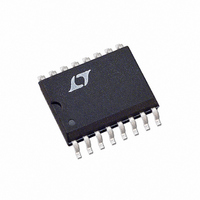LTC1164-5CSW#TRPBF Linear Technology, LTC1164-5CSW#TRPBF Datasheet - Page 9

LTC1164-5CSW#TRPBF
Manufacturer Part Number
LTC1164-5CSW#TRPBF
Description
IC FILTR 8TH ORDR LOWPASS 16SOIC
Manufacturer
Linear Technology
Datasheet
1.LTC1164-5CNPBF.pdf
(16 pages)
Specifications of LTC1164-5CSW#TRPBF
Filter Type
Butterworth or Bessel Lowpass
Frequency - Cutoff Or Center
20kHz
Number Of Filters
1
Max-order
8th
Voltage - Supply
4.75 V ~ 16 V, ±2.375 V ~ 8 V
Mounting Type
Surface Mount
Package / Case
16-SOIC (0.300", 7.5mm Width)
Number Of Circuits
Single
Cutoff Frequency
20KHz
Order Filter (max)
8th
Single Supply Voltage (typ)
5V
Power Supply Requirement
Single/Dual
Single Supply Voltage (min)
4.75V
Single Supply Voltage (max)
16V
Dual Supply Voltage (min)
±2.375V
Dual Supply Voltage (max)
±8V
Operating Temperature (min)
-40C
Operating Temperature (max)
85C
Package Type
SOIC W
Lead Free Status / RoHS Status
Lead free / RoHS Compliant
Available stocks
Company
Part Number
Manufacturer
Quantity
Price
PI FU CTIO S
Butterworth/Bessel (Pin 10)
The DC level at Pin 10 determines the ratio of the clock
frequency to the cutoff frequency of the filter. Pin 10 at V
gives a 50:1 ratio and a Butterworth response (pins 1 to 13
are shorted for 50:1 only). Pin 10 at V
Butterworth response. Pin 10 at ground gives a Bessel
response and a ratio of 140:1. For single supply operation
the ratio is 50:1 when Pin 10 is at V
100:1 when Pin 10 is at ground, and 140:1 when at 1/2
supply. When Pin 10 is not tied to ground, it should be
bypassed to analog ground with a 0.1µF capacitor. If the
DC level at Pin 10 is switched mechanically or electrically
at slew rates greater than 1V/µs while the device is
operating, a 10k resistor should be connected between
Pin 10 and the DC source.
Filter Input (Pin 2)
The input pin is connected internally through a 100k
resistor tied to the inverting input of an op amp.
Filter Output (Pins 9, 6)
Pin 9 is the specified output of the filter; it can typically
source or sink 1mA. Driving coaxial cables or resistive
loads less than 20k will degrade the total harmonic distor-
tion of the filter. When evaluating the device’s distortion an
output buffer is required. A noninverting buffer, Figure 3,
can be used provided that its input common mode range
APPLICATIO S I FOR ATIO
Clock Feedthrough
Clock feedthrough is defined as, the RMS value of the
clock frequency and its harmonics that are present at the
filter’s output pin (Pin 9). The clock feedthrough is tested
with the input pin (Pin 2) grounded and, it depends on PC
board layout and on the value of the power supplies. With
proper layout techniques the values of the clock feedthrough
are shown in Table 2.
U
U
U
U
U
+
(Pins 1 to 13 shorted),
W
–
gives a 100:1
U
+
is well within the filter’s output swing. Pin 6 is an interme-
diate filter output providing an unspecified 6th order
lowpass filter. Pin 6 should not be loaded.
External Connection (Pins 7, 14 and 1, 13)
Pins 7 and 14 should be connected together. In a printed
circuit board the connection should be done under the IC
package through a short trace surrounded by the analog
ground plane. When the clock to cutoff frequency ratio is
set at 50:1, Pin 1 should be shorted to Pin 13; if not, the
passband will exhibit 1dB of gain peaking and it will deviate
from a Butterworth response. Pin 1 is the inverting input
of an internal op amp and it should preferably be 0.2 inches
away from any other circuit trace.
NC (Pin 8)
Pin 8 is not connected to any internal circuit point on the
device and should be preferably tied to analog ground.
Table 2. Output Clock Feedthrough
Note: The clock feedthrough at ±2.5V supplies is imbedded in the
wideband noise of the filter. The clock waveform is a square wave.
±2.5V
±7.5V
±5V
V
S
Figure 3. Buffer for Filter Output
1k
100µV
150µV
60µV
–
+
50:1
LT1056
RMS
RMS
RMS
LTC1164-5
1164-5 F03
200µV
500µV
60µV
100:1
RMS
RMS
RMS
11645fc
9
















